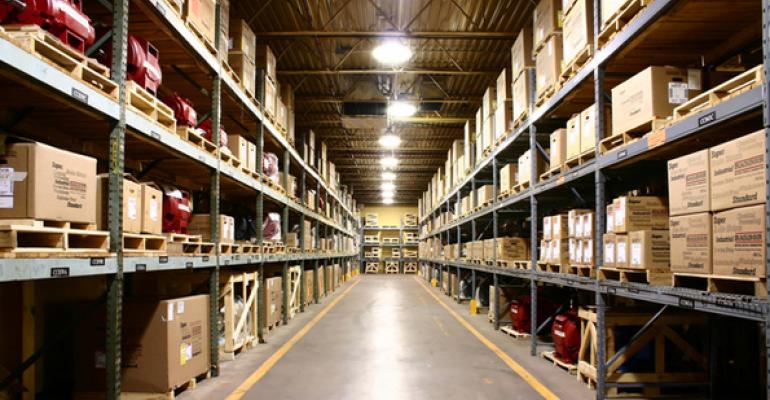Industrial vacancy is at an all-time low, declining by 70 basis points from a year ago to an aggregate nationwide vacancy of 5.6 percent in the fourth quarter of 2016, according to the year-end industrial market report from real estate services firm JLL. JLL researcher Aaron Ahlburn says that the former record low vacancy was in 2000, when the rate dipped to a 7.0-8.0 percent range as a result of market expansion coming out of the dot.com bubble.
“There are few prime opportunities for tenants right now, with 64 million square feet absorbed in the fourth quarter alone,” he says, noting that e-commerce fulfillment is the strongest dynamic driving industrial demand today. E-commerce accounts for 22.5 percent of all big-box transactions, compared with 3PLs (third-party logistics), at 15.2 percent, consumer non-durables, at 12.1 percent, and traditional retail, at 10.4 percent. From 2010 to 2014, e-commerce was in third place nationally, accounting for just 16.1 percent of big-box activity.
Increasing competition for industrial space has caused rental rates to hit record highs, breaking the $5 per sq. ft. triple-net barrier for the first time, Ahlburn notes, and has set off a building boom. New deliveries nationwide in 2016 totaled 224.5 million sq. ft., compared to the previous record high of 199.2 million sq. ft. in 2008.
Speculative industrial development comprised 70.7 percent of the total, with 24.3 percent accounting for build-to-suit projects, and owner-built facilities making up the remaining 5.0 percent of construction. That industrial development is more structured this time around, Ahlburn notes, with no oversupply foreseeable as happened in the 2000 boom. This is evidenced by the strong 24.4 percent pre-leasing rate of industrial space under construction.
The e-commerce industry is evolving new a industrial model that makes efficient use of space. Property features include up to 40-foot high clearance to accommodate innovative warehouse management systems, specialized material handling equipment and racking—all of which help expedite delivery. Air conditioning is a must, as well as extensive truck doors and trailer parking to meet the high volume of orders, adequate and redundant facility power with back-up generators for uninterrupted operations on shipping days and cross-dock configuration to enhance the flow of goods in and out of facilities.
Developers are also building market-specific product, including omni-channel fulfillment centers larger than 500,000 sq. ft. in markets that offer access to the nation’s key population centers; mid-size facilities of 300,000 to 500,000 sq. ft. in secondary markets; and smaller size facilities in locations near consumers to meet same-day and next-day delivery expectations.
Even with this much new space coming on-line, Ahlburn notes that demand is so strong, it is still outpacing new product deliveries. As expected, major markets like Chicago and Philadelphia are seeing increased absorption of industrial stock, but some secondary, Midwestern markets are experiencing even greater space absorption in relation to market size and industrial stock.
Comparing the change in net absorption of industrial space, Chicago—a massive logistics market—experienced a 2.1 percent increase, while increases in industrial absorption for Indianapolis and Columbus were 4.5 percent and 3.8 percent, respectively. Ahlburn notes that this percentage is obtained by dividing the total net absorption by size of the market’s industrial stock.
Over the last two years, e-commerce accounted for 61.2 percent of big-box activity in Indianapolis. Columbus, Cincinnati and St. Louis also experienced a spike in e-commerce deals during the same period and now rank in the top 10 nationally for e-commerce transactions.
Industrial tenants are not only having difficulty finding prime warehouse space, they are also having trouble finding adequate labor, according to another JLL report on the effects of e-commerce on industrial real estate and logistics. The report noted that the labor shortage has resulted from a combination of the low unemployment rate and the more labor-intensive environment of e-commerce fulfillment centers. These fulfillment centers include packaging personnel, as well as labor and freight stockers, requiring one employee per 700–1,000 sq. ft., rather than one employee per 1,500-3,000 sq. ft. at traditional warehouse operations.
As a result, e-commerce-focused leasing is driving up local demand for labor at a rate two to three times that of traditional warehousing operations, noted the report. It has also accelerated wage growth for warehouse labor, with wage growth for labor and freight stockers outpacing other occupations, rising 5.8 percent nationally between 2013 and 2015 and just a 2.7 percent for other occupations.
Ahlburn says that 2017 is expected to be another solid year for industrial product, with high demand providing opportunities for industrial developers. He also suggests that investors consider secondary markets in the Midwest experiencing phenomenal growth in e-commerce.
He notes, however, that with the uncertainty associated with the current administration’s focus on a more closed trade policy and many brick-and-mortar retail stores closing, JLL is closely monitoring how changes in global trade and increasing online retail sales affect industrial real estate.

